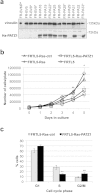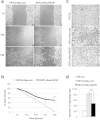PATZ1 is a target of miR-29b that is induced by Ha-Ras oncogene in rat thyroid cells
- PMID: 27125250
- PMCID: PMC4850481
- DOI: 10.1038/srep25268
PATZ1 is a target of miR-29b that is induced by Ha-Ras oncogene in rat thyroid cells
Abstract
The regulatory transcriptional factor PATZ1 is constantly downregulated in human thyroid cancer where it acts as a tumour suppressor by targeting p53-dependent genes involved in Epithelial-Mesenchymal Transition and cell migration. The aim of the present work was to elucidate the upstream signalling mechanisms regulating PATZ1 expression in thyroid cancer cells. The bioinformatics search for microRNAs able to potentially target PATZ1 led to the identification of several miRNAs. Among them we focused on the miR-29b since it was found upregulated in rat thyroid differentiated cells transformed by the Ha-Ras oncogene towards a high proliferating and high migratory phenotype resembling that of anaplastic carcinomas. Functional assays confirmed PATZ1 as a target of miR-29b, and, consistently, an inverse correlation between miR-29b and PATZ1 protein levels was found upon induction of Ha-Ras oncogene expression in these cells. Interestingly, restoration of PATZ1 expression in rat thyroid cells stably expressing the Ha-Ras oncogene decreased cell proliferation and migration, indicating a key role of PATZ1 in Ras-driven thyroid transformation. Together, these results suggest a novel mechanism regulating PATZ1 expression based on the upregulation of miR-29b expression induced by Ras oncogene.
Figures




References
-
- Rahib L. et al. Projecting cancer incidence and deaths to 2030: the unexpected burden of thyroid, liver, and pancreas cancers in the United States. Cancer Res. 74, 2913–2921 (2014). - PubMed
-
- Kondo T., Ezzat S. & Asa S. L. Pathogenetic mechanisms in thyroid follicular-cell neoplasia. Nat. Rev. Cancer. 6, 292–306 (2006). - PubMed
-
- Nikiforov Y. E. & Nikiforova M. N. Molecular genetics and diagnosis of thyroid cancer. Nat. Rev. Endocrinol. 7, 569–580 (2011). - PubMed
-
- Zhu Z., Gandhi M., Nikiforova M. N., Fischer A. H. & Nikiforov Y. E. Molecular profile and clinical-pathologic features of the follicular variant of papillary thyroid carcinoma. An unusually high prevalence of ras mutations. Am. J. Clin. Pathol. 120, 71–77 (2003). - PubMed
Publication types
MeSH terms
Substances
LinkOut - more resources
Full Text Sources
Other Literature Sources
Molecular Biology Databases
Research Materials
Miscellaneous

